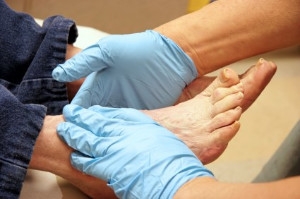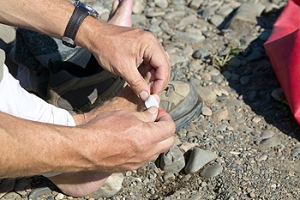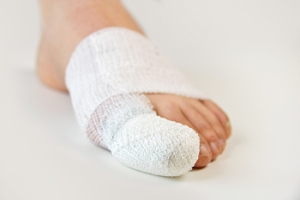Items filtered by date: September 2024
Facts About Clubfoot
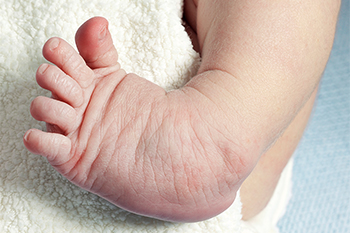
Clubfoot, medically referred to as talipes equinovarus, is a congenital deformity affecting roughly one in every 1,000 newborns. Clubfoot occurs when the feet turn inward and upward toward the ankle, affecting either one or both feet. While it is more common in boys than girls, there is no definitive cause for clubfoot, though genetics and environmental factors may play a role. If untreated, it can significantly impact a child’s ability to walk, leading to pain and long-term mobility issues. Fortunately, early intervention with treatments such as the Ponseti Method can help correct the congenital deformity. This non-invasive technique involves a series of casts, sometimes followed by a minor surgical procedure to lengthen the Achilles tendon, and a brace to maintain foot alignment. With prompt attention, most children with clubfoot can develop healthy, functional feet. If your child has clubfoot, it is suggested that you make an appointment with a podiatrist for an exam, diagnosis, and treatment options.
Congenital foot problems require immediate attention to avoid future complications. If you have any concerns, contact Dr. Kenneth Donovan of Advanced Care Foot and Ankle. Our doctor can provide the care you need to keep you pain-free and on your feet.
Congenital foot problems are deformities affecting the feet, toes, and/or ankles that children are born with. Some of these conditions have a genetic cause while others just happen. Some specific foot ailments that children may be born with include clubfeet, polydactyly/macrodactyly, and cleft foot. There are several other foot anomalies that can occur congenitally. What all of these conditions have in common is that a child may experience difficulty walking or performing everyday activities, as well as trouble finding footwear that fits their foot deformity. Some of these conditions are more serious than others. Consulting with a podiatrist as early as possible will help in properly diagnosing a child’s foot condition while getting the necessary treatment underway.
What are Causes of Congenital Foot Problem?
A congenital foot problem is one that happens to a child at birth. These conditions can be caused by a genetic predisposition, developmental or positional abnormalities during gestation, or with no known cause.
What are Symptoms of Congenital Foot Problems?
Symptoms vary by the congenital condition. Symptoms may consist of the following:
- Clubfoot, where tendons are shortened, bones are shaped differently, and the Achilles tendon is tight, causing the foot to point in and down. It is also possible for the soles of the feet to face each other.
- Polydactyly, which usually consists of a nubbin or small lump of tissue without a bone, a toe that is partially formed but has no joints, or an extra toe.
- Vertical talus, where the talus bone forms in the wrong position causing other bones in the foot to line up improperly, the front of the foot to point up, and the bottom of the foot to stiffen, with no arch, and to curve out.
- Tarsal coalition, when there is an abnormal connection of two or more bones in the foot leading to severe, rigid flatfoot.
- Cleft foot, where there are missing toes, a V-shaped cleft, and other anatomical differences.
- Macrodactyly, when the toes are abnormally large due to overgrowth of the underlying bone or soft tissue.
Treatment and Prevention
While there is nothing one can do to prevent congenital foot problems, raising awareness and receiving neonatal screenings are important. Early detection by taking your child to a podiatrist leads to the best outcome possible.
If you have any questions please feel free to contact one of our offices located in Warren, Livingston, and Toms River, NJ . We offer the newest diagnostic tools and technology to treat your foot and ankle needs.
Foot Problems From Diabetic Patients

Foot problems are a common and serious concern for individuals with diabetes, often leading to complications like diabetic foot ulcers. Diabetes can cause nerve damage and poor blood circulation, making the feet more prone to injuries that might go unnoticed due to reduced sensation. The lack of feeling increases the risk of wounds, blisters, and ulcers, which can worsen without proper care. Diabetic foot ulcers can take a long time to heal and may lead to infections if not treated properly. Podiatrists play a vital role in managing diabetes related foot issues. They can perform necessary treatments, such as debridement to remove dead tissue, suggest appropriate footwear to alleviate pressure on affected areas, and provide wound care solutions. If you have a foot problem related to diabetes, it is suggested that you schedule an appointment with a podiatrist for regular monitoring and care.
Diabetic foot care is important in preventing foot ailments such as ulcers. If you are suffering from diabetes or have any other concerns about your feet, contact Dr. Kenneth Donovan from Advanced Care Foot and Ankle. Our doctor can provide the care you need to keep you pain-free and on your feet.
Diabetic Foot Care
Diabetes affects millions of people every year. The condition can damage blood vessels in many parts of the body, especially the feet. Because of this, taking care of your feet is essential if you have diabetes, and having a podiatrist help monitor your foot health is highly recommended.
The Importance of Caring for Your Feet
- Routinely inspect your feet for bruises or sores.
- Wear socks that fit your feet comfortably.
- Wear comfortable shoes that provide adequate support.
Patients with diabetes should have their doctor monitor their blood levels, as blood sugar levels play such a huge role in diabetic care. Monitoring these levels on a regular basis is highly advised.
It is always best to inform your healthcare professional of any concerns you may have regarding your feet, especially for diabetic patients. Early treatment and routine foot examinations are keys to maintaining proper health, especially because severe complications can arise if proper treatment is not applied.
If you have any questions please feel free to contact one of our offices located in Warren, Livingston, and Toms River, NJ . We offer the newest diagnostic and treatment technologies for all your foot and ankle needs.
Causes and Types of Blisters on Toes
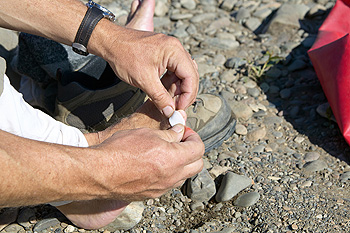
Blisters on toes can arise from various causes, each affecting the foot differently. The most common trigger is friction from wearing ill-fitting shoes or repetitive rubbing, which can lead to clear blisters filled with fluid that cushions the damaged skin. Blood blisters occur when friction causes blood vessels to break beneath the skin, resulting in a darker, purplish blister. Infected blisters are more concerning, often developing from open sores or cuts that become contaminated with bacteria. These blisters may appear red, swollen, and filled with pus, indicating an infection. Wearing proper footwear, moisture-wicking socks, and prompt treatment of open blisters can help prevent these issues. If you notice blisters are frequently forming on your feet or toes, it is suggested that you consult a podiatrist who can determine what the cause is, and offer effective treatment and prevention techniques.
Blisters may appear as a single bubble or in a cluster. They can cause a lot of pain and may be filled with pus, blood, or watery serum. If your feet are hurting, contact Dr. Kenneth Donovan of Advanced Care Foot and Ankle. Our doctor can provide the care you need to keep you pain-free and on your feet.
Foot Blisters
Foot blisters are often the result of friction. This happens due to the constant rubbing from shoes, which can lead to pain.
What Are Foot Blisters?
A foot blister is a small fluid-filled pocket that forms on the upper-most layer of the skin. Blisters are filled with clear fluid and can lead to blood drainage or pus if the area becomes infected.
Symptoms
(Blister symptoms may vary depending on what is causing them)
- Bubble of skin filled with fluid
- Redness
- Moderate to severe pain
- Itching
Prevention & Treatment
In order to prevent blisters, you should be sure to wear comfortable shoes with socks that cushion your feet and absorb sweat. Breaking a blister open may increase your chances of developing an infection. However, if your blister breaks, you should wash the area with soap and water immediately and then apply a bandage to the affected area. If your blisters cause severe pain it is important that you call your podiatrist right away.
If you have any questions, please feel free to contact one of our offices located in Warren, Livingston, and Toms River, NJ . We offer the newest diagnostic and treatment technologies for all your foot care needs.
Walking With a Broken Toe
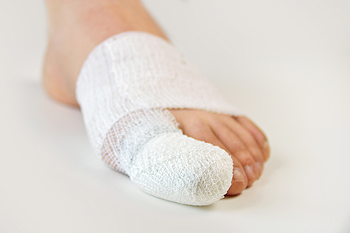
Walking with a broken big toe can be incredibly painful and may hinder your daily activities. Despite the discomfort, many people continue to walk with a broken toe, which can lead to complications like improper healing or worsening the injury. While it is tempting to tough it out, seeking professional medical care is important. A podiatrist can assess the severity of the break, determine whether the bone is aligned, and suggest appropriate treatment. Depending on the injury, this may include buddy taping the toe to an adjacent one, using a splint, or even recommending a specialized shoe to reduce pressure. This may also help to protect the toe and allow proper healing. Ignoring a broken big toe can lead to chronic pain, deformities, or arthritis in the joint. Your podiatrist can provide guidance on when it is safe to resume normal activities to avoid re-injury. If you have a broken big toe, it is suggested that you schedule an appointment with a podiatrist for an exam and treatment.
A broken toe can be very painful and lead to complications if not properly fixed. If you have any concerns about your feet, contact Dr. Kenneth Donovan from Advanced Care Foot and Ankle. Our doctor will treat your foot and ankle needs.
What to Know About a Broken Toe
Although most people try to avoid foot trauma such as banging, stubbing, or dropping heavy objects on their feet, the unfortunate fact is that it is a common occurrence. Given the fact that toes are positioned in front of the feet, they typically sustain the brunt of such trauma. When trauma occurs to a toe, the result can be a painful break (fracture).
Symptoms of a Broken Toe
- Throbbing pain
- Swelling
- Bruising on the skin and toenail
- The inability to move the toe
- Toe appears crooked or disfigured
- Tingling or numbness in the toe
Generally, it is best to stay off of the injured toe with the affected foot elevated.
Severe toe fractures may be treated with a splint, cast, and in some cases, minor surgery. Due to its position and the pressure it endures with daily activity, future complications can occur if the big toe is not properly treated.
If you have any questions please feel free to contact one of our offices located in Warren, Livingston, and Toms River, NJ . We offer the newest diagnostic and treatment technologies for all your foot and ankle needs.

